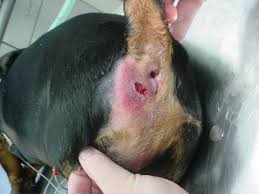Anal glands are, literally, a pain in the butt for some cats and dogs and their owners. Many dogs and cats with chronic anal gland issues are presented to veterinarians or groomers every few weeks to have the glands manually expressed. These poor pets lick their anal area and under their tails, scoot across the floor, and generally deal with chronic pain and irritation. Does the solution really lie in more trips to the veterinarian or groomer to have the glands emptied?
Actually, the more the glands are manually expressed, the more scar tissue builds up from mechanical damage. The procedure becomes more difficult to perform and more painful for the pet. Inexperienced or rough handling can cause more trauma to an already inflamed area. Irritation in that area causes the pet to lick more, which leads to skin infections with yeast and bacteria. A bad situation becomes worse. So what's the solution?
A high quality diet that gives a well-formed stool is your best defense. The diet needs to contain a lot of moisture (ie - not kibble), some insoluble fiber, +/- ground bone (yes, if feeding raw). A firm stool will apply pressure as it passes by the glands, causing them to express. A high dose of insoluble fiber, like ground pumpkin seed or psyllium husk, will add bulk to the stool. Ground bone will also add bulk, but helps with formation of a solid stool. For those that feed raw with ground bone, they know what the stool looks like - almost white and chalky when it dries.
A high moisture diet keeps the discharge in the glands from becoming thick and sludgy. A kibble-based diet is very low moisture. (Even if you add water to the kibble, it does not re-hydrate to the same level that a raw diet would. See blog here.) Raw, home cooked, and canned diets provide a much higher level of moisture, up to 80 to 85% in some cases. This added moisture helps keep the anal gland discharge in a more liquid state. When I do have to express anal glands at the office, I know there is trouble brewing if the discharge comes out like thick toothpaste instead of liquid. This is particularly a problem in cats fed kibble.
There are products on the market that can help with anal gland issues, but they are really aimed at providing insoluble fiber. If you are unable to change the diet, these products may be helpful. I have never needed this products with my raw-fed dogs. We normally have 8 to 10 dogs at any given time; in the past fifteen years we have had two anal gland abscesses. Personally, I'm not happy that we had any, but as they say, "poop happens".
Disclaimer: This content is for informational purposes only and is not meant to diagnose, treat, or replace consulting a primary veterinarian for individualized care.

